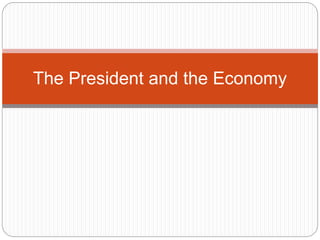
President tax and spend
- 1. The President and the Economy
- 2. Government Spending • The government currently spends roughly $3 trillion per year, a figure that can be broken down into four major components: – direct benefit payments to individuals, including Social Security, health, and welfare programs; – national defense; Comparing Governments: Government Revenue and Expenditures
- 3. – discretionary spending including spending on the environment, transportation, criminal justice, and other areas; and – interest on the national debt. Comparing Governments: Government Revenue and Expenditures
- 4. Figure 1
- 5. Figure 3
- 6. Taxes as a Source of Revenue • Taxes are payments made by individuals and businesses to support government activities. • The individual income tax is the federal government’s biggest single source of revenue. • The federal income tax is levied on a person’s taxable income, an individual’s total income minus certain deductions and exemptions.
- 7. Taxes as a Source of Revenue (cont.) • Excise taxes are taxes on the manufacture, transportation, sale, or consumption of goods and the performance of services. • Taxes levied on imported goods are called customs duties, tariffs, or import duties. • An estate tax is a tax on property and money left after someone has died.
- 8. Borrowing for Revenue • In addition to collecting taxes, the federal government borrows money. • The government borrows by selling federal securities—financial instruments that include bonds, notes, and treasury bills. • Government borrowing to fund annual budget deficits over time creates the national debt. • The size of the national debt affects the federal budget and the economy.
- 9. Fiscal and Monetary Policy • The government can influence the economy in two main ways: – Fiscal policy involves using government spending and taxation to influence the economy. – Monetary policy involves controlling the supply of money and credit to influence the economy.
- 10. Fiscal and Monetary Policy (cont.) • When the government increases spending or reduces taxes, it is likely to run a deficit because it must spend money that it does not have. • Since the 1930s, the United States has had deficit, or unbalanced, federal budgets. The Public Debt, 1940-2008
- 11. Figure 4
- 12. The Federal Reserve System • The Federal Reserve System, known as the Fed, is the central banking system of the United States. • When banks need money, they borrow from the Fed.
- 13. The Federal Reserve System (cont.) • The United States is divided into 12 Federal Reserve Districts. • Each district has one main Federal Reserve Bank. • Most Federal Reserve Banks have branch banks within their districts. Federal Reserve Districts
- 14. Figure 5
- 15. The Federal Reserve System (cont.) • The Fed uses four main tools to control the financial activities of the nation’s banks: – The discount rate is the rate the Fed charges member banks for loans. – The Fed can raise or lower the reserve requirement—the money banks must keep in their vaults or on deposit with the Federal Reserve Banks.
- 16. The Federal Reserve System (cont.) – The Fed can put money into the economy by buying government bonds on the open market—open-market operations. – The Fed may sell government securities.